Genus Opuntia (incl. Cylindropuntia, Grusonia, and Corynopuntia)
English names: prickly pear, cholla, opuntia, choya, cane cactus
Spanish names: nopal, tuna, cholla
The genus Opuntia is quite large, yet it is still replete with hidden diversity. The more closely botanists study these plants the more species they discover. People who live with and use these plants recognize even more differences between them than do botanists. Juanita Ahil was a Tohono O’odham who lived in the desert near Sells, Arizona. Ecologist Tony Burgess could recognize two species of opuntia growing in Juanita’s yard. Juanita was able to distinguished five different kinds from the appearance of the prickly pear pads alone. Later, the characteristics of the fruits these plants produced confirmed that she was correct; the fruits differed accordingly in color, taste, and keeping qualities.
Description
Opuntia has been the main genus in the opuntioid subfamily of Cactaceae. (A new classification system for this group is underway; see below. Until this revision, all of the other cacti in the Sonoran Desert region are in the cereoid subfamily.) The Opuntioid are distinguished from other cacti by four characteristics. First, the stems grow in distinctly jointed segments. The elongation of joints is permanently terminated by the onset of the dry season; subsequent growth of the plant occurs by the initiation of new joints by branching from the areoles. (Other cacti have indeterminate growth. A saguaro stem, for example, grows ever longer each growing season until the plant dies or the stem tip is damaged.) Second, whether or not they have regular spines, opuntioid areoles bear glochids (usually small to minute, barbed spines that are very sharp and brittle, and very easily detached). Third, rudimentary leaves are present on new joints. Fourth, the seeds have a pale covering called an aril; most other cacti have shiny black seeds. The largest genus, Opuntia, has at least 300 species of shrubby or arborescent plants worldwide. The vernacular names are based on growth form. The chollas (most of our species are in the subgenus Cylindropuntia) have cylindrical stem segments, while those of prickly pears (subgenus Platyopuntia) are flattened.
Range
The genus ranges from southern Canada to southern South America, in habitats ranging from arid desert to tropical semiarid woodlands and high mountains.
Notes
In general, chollas are more drought tolerant than prickly pears and extend into drier deserts. Less arid habitats tend to have more prickly pear species. All desert species are pollinated by a few species of bees that specialize in cacti; they collect the pollen to feed developing larvae. Some opuntia flowers emit a fragrance of damp earth; perhaps the smell resembles “home”to the ground-nesting bees. Mature fruit ranges from tan or green and dry to bright red or purple with juicy pulp; all contain large, very hard seeds. Many birds, mammals, and insects feed on the fleshy fruits; so may desert tortoises and spiny iguanas. Though all species flower, some rarely, if ever, produce viable seeds; these species reproduce almost entirely by vegetative means.
Both prickly pears and chollas provide shelter for numerous animals. White-throated wood rats (packrats) build nests of sticks and other debris within the shrubby prickly pears. (The shrubby ones are those with thickets of pads on the ground, as opposed to the trunked species, such as santa-rita prickly pear). Packrats cover their houses with a layer of cholla joints, if available. In more exposed locations the nest may consist almost entirely of piled-up cholla joints. These nests provide good protection from coyotes, but not from snakes, which can enter the nests along the trails used by packrats. (Rattlesnakes commonly take up residence in packrat nests, usually after eating or evicting the packrat.) Cactus wrens prefer to build their nests among the stems of chollas. Curve-billed thrashers, mourning doves, roadrunners, and other birds also commonly use both chollas and prickly pears as fairly secure nesting and roosting sites.
The flesh of prickly pears and some chollas is eaten by jackrabbits, packrats, and javelina, all of which can deal with concentrations of oxalic acid that can be toxic to many animals and can clog the kidneys of species with highly concentrated urine. Several insects have also coevolved with cacti as their sole food source. The most conspicuous are the giant cactus beetle (Moneilema gigas), cactus weevils (Metamasmius spp.), cochineal (Dactylopius spp.), and a moth (genus Copidryas cosyra) with very colorful but rarely-seen larvae that feed on fresh cholla stems. Read about the blue cactus borer (Cactobrosis) in the saguaro section.
Opuntias are extensively used for food and other purposes by humans. The fleshy fruit (called tuna in Spanish) of some species (O. engelmannii in Arizona Upland) is edible and tasty. It can be eaten fresh, if care is taken to avoid the glochids on the rind. More often the brilliant red-purple and distinctly-flavored juice is expressed to make drinks, syrup, and jelly. Some prickly pear species are commercially cultivated for fruit production; numerous superior cultivated varieties have been selected.
The formidable flower buds of some chollas are eaten by O’odham and other desert dwelling peoples. The buds are rolled on the ground or another hard surface with sticks to remove the spines and glochids. The buds are pit-roasted for a day, and either eaten immediately or dried and pickled for later consumption. Cholla buds contain significant protein, but they are probably more important for their high calcium content and soluble fiber. The O’odham harvested and ate them early in the dry season after the last year’s crops had been consumed, and before saguaro fruits ripened. Cholla buds are still part of the traditional O’odham diet. The Hohokam, predecessors to the O’odham, also ate cholla buds, and there is evidence that they cultivated chollas around their homes.
Millions of people cook and eat the tender young pads of several species of prickly pear. Besides being more tender, immature pads have less oxalic acid, which could be toxic in large amounts. Nopales (the edible species of prickly pear and the harvested whole pads of the same) are very nutritious. Nopalitos (small pads that are cut into bite-size pieces) are mucilaginous like okra, and good for thickening broths. The mucilage also helps control blood-sugar levels associated with adult-onset diabetes. Diabetes is a common affliction among native Americans who adopt Western high-fat, low-fiber diets. There is also clinical evidence that nopales reduce blood cholesterol. Widely ignored by Anglos, who often regard them as worthless nuisances, opuntias are abundant and healthy foods for those who know how to use them.
Prickly pears are a historically important reason that the Spaniards continued their conquest of the New World. They quickly looted the precious metals they were after, but they also discovered cochineal. Cochineal is a scale insect that feeds on prickly pears. Its body fluids contain a bright crimson, foul-tasting substance that protects it from predators. Ground up cochineal insects were used by native peoples to dye their textiles rich red or purple, depending on the processing. In Europe this color of dye was so rare that only royalty could afford it. In some kingdoms the colors “royal purple”(derived from a sea cucumber) and, after discovery of the New World, royal crimson from cochineal, were reserved for the king by law. The cultivation and export of cochineal dye became a major economic activity, and its source was kept secret for many years. The commercial cochineal was harvested and later cultivated from prickly pears in southern Mexico. Our Sonoran Desert species contain the same dye.
When competitors finally discovered the source of the coveted dye, they attempted to establish populations of prickly pears and cochineal in other countries such as India, Ceylon, South Africa, and Australia. In many cases the cochineal died out, but the prickly pears escaped into the wild and became serious pests.
The cochineal industry thrived until the late 1800s, when cheaper aniline dyes became available. However, there is still significant commercial cochineal production in several countries, including Mexico. Cochineal is one of a very few red dyes approved by the U.S. Food and Drug Administration. (Earlier red food colorings were found to be carcinogens and were banned.) Today red candies, beverages, and lipstick are often colored with bug blood raised on prickly pears. Despite its evolutionary origin as an anti-predator toxin, the quantities used to color foods are nontoxic to humans, except for occasional allergic reactions (which can be caused by almost any substance).
The juice expressed from prickly pears has been used for centuries to strengthen adobe mortar. It was recently used in the restoration of the San Xavier Mission in Tucson. It is being tested for similar applications, such as stabilizing dirt footpaths and erosion-prone slopes.
Recent genetic studies reveal that the different subgenera of this genus may be distinct enough to warrant their elevation to full genera. In our region there would be 3 new ones: Opuntia would include all Sonoran region prickly pears. Most chollas will be in Cylindropuntia, and the few club chollas will be placed in Grusonia or Corynopuntia.
Numerous species of cholla and some prickly pears hybridize with one another. Hybrid populations are fairly common. Some of these hybrids may reproduce sexually; others are sexually sterile but can reproduce vegetatively. There are several such “clonal microspecies” in the Tucson area alone, some of which are restricted to a patch of just a few acres (hectares). Most of the descriptions of these species are published only in scientific monographs and have not yet appeared in general plant lists and keys. So if you are frustrated with being unable to identify a cholla or prickly pear from a field guide, be assured that you’re not alone. No field guide can cover all the possible hybrids and “microspecies.”(See also the note under Opuntia acanthocarpa.)
Opuntias have captured the imagination of botanists as reflected in some of their names. My two favorites are from Baja California. Opuntia (Grusonia) invicta roughly translates “invincible points”; its English vernacular name is devil’s club cholla. This cactus forms low mounds of ovoid joints covered with broad, 3-inch (7.5 cm) long spines like little daggers. Even better is Opuntia (Cylindropuntia) molesta—no translation needed. It’s a shrub sometimes over 8 feet (2.4 m) tall, and its spines are 2 inches (5 cm) long and incredibly sharp. I have mused that the botanist who named it might have discovered it in the same manner as I did. There were hundreds of 2 foot (60 cm) tall plants on a gravelly wash bed. It was a wet spring and the grass was 3 feet tall. . . .
Opuntia [Cylindropuntia] acanthocarpa
English name: buckhorn cholla
Spanish names: cholla, tasajo
Opuntia [Cylindropuntia] versicolor
English name: staghorn cholla
Spanish names: tasajo, cholla morada (purple cholla)
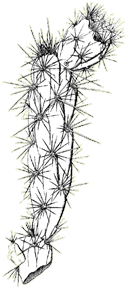 |
Description
These 2 species are rather difficult to differentiate where they occur together. Both have many thin branches arising from the ground or a short trunk. Buckhorn cholla is usually about 3 feet (0.9 m) tall, but can reach 13 feet (4 m). Staghorn cholla is usually 3 to 8 feet (0.9-2.4 m) tall, but occasionally reaches 15 feet (4.6 m). The stems of both species may be tinged with red or purple, especially in winter; staghorn cholla more often exhibits this trait. Both species have variable flower colors, ranging from red, yellow, orange, pink, purple, and greenish or brownish, often all in the same local population. The anther-bearing filaments of buckhorn are dark red; staghorn filaments are yellowish green. The flowers of buckhorn cholla tend to be larger than those of staghorn; both bloom in spring.
The fruits provide the best way to distinguish the 2 species when they are not in bloom. At maturity the fruit of buckhorn cholla is dry, deeply tuber-culate, and covered with long, barbed spines. Fruits fall from the plant after several months. Staghorn cholla fruit is fleshy at maturity, turgid, usually spineless, and persists on the plant for more than a year. Thus staghorn cholla is always in fruit when mature.
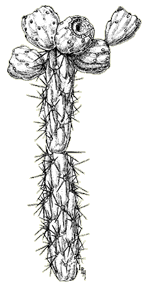 |
Range
Buckhorn cholla is widespread in the northern Sonoran and Mohave deserts to about 4000 feet (1220 m). Staghorn cholla is restricted to Pinal, Santa Cruz, and eastern Pima counties in Arizona and northern Sonora, Mexico, at 2000 to 3000 feet (600-900 m) elevation.
Notes
Because they are less spiny than O. bigelovii and O. fulgida, which usually grow with them, buckhorn and staghorn chollas are less favored nesting sites for birds. Buckhorn, staghorn, and pencil chollas are the preferred sources of cholla buds eaten by the Tohono O’odham and other Native Americans.
Besides the variability of flower color, buckhorn cholla is extremely variable in vegetative characters, such as plant height and branching angle, color, number, and size of spines and size and shape of tubercles. Taxonomists have distinguished 4 varieties, and almost every mountain range and valley has a different-looking population. Perhaps they and many other opuntias are in the process of evolving into new species.
Opuntia arbuscula [Cylindropuntia arbuscula]
English name: pencil cholla
Spanish names: tasajo, cholla,
chumbera, chollita
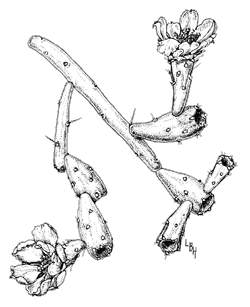 |
Description
This cholla, densely-branched, but often with a distinct trunk, grows up to 9 feet (3 m) in height, but is usually less tall. The slender joints are 2 to 4 inches (5-10 cm) long and ¼ inch (15 mm) in diameter. Usually joints are sparsely-spined, with each areole bearing 1 long yellow central spine and 1 to 3 short radial spines. Green, yellow, or brownish-red flowers in spring are followed by fleshy, greenish-purple fruits that remain on the plant for at least a year.
Range
This cactus occurs from Central Arizona to northern Sonora, at 1000 to 3000 feet (300-900 m) elevation.
Opuntia basilaris
English name: beavertail cactus
Spanish name: nopal
Description
New pads of this species grow mostly from bases of older ones, resulting in sprawling plants seldom more than 2 pads tall. Clumps grow up to 6 feet (1.8 m) in diameter. The pads are spineless, but have many hair-like glochids that make the areoles look like dots of felt. The incandescent-pink flowers appear from late February at the lowest elevations to May at the highest. The dry fruits contain very large seeds, even for an opuntia.
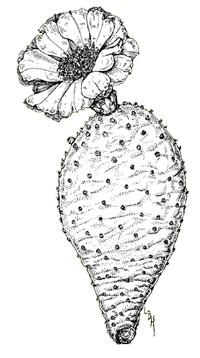 |
Range
Beavertail grows from near sea level to 6000 feet (1800 m) in the Mohave and northwestern Sonoran deserts to southern Utah; it barely enters Sonora.
Notes
Nearly everyone who has had a close encounter with this or other “spineless” opuntias would rather have dealt with spines. Glochids are often too small to see, and they cause prickling pain and intense itching as the barbs work deeper into the skin with every movement. Removing hundreds or thousands of them after falling into such a plant is an exhausting and tormenting task. Some people shave them off at skin level, which somewhat reduces the irritation, even though this leaves the tips beneath the skin. A better remedy is to gently draw very sticky tape across the afflicted skin. Another effective treatment is to cover the area with a layer of white glue, then peel it off after it dries.
Opuntia biglovii [Cylindropuntia bigelovii]
English names: teddy bear cholla, jumping cactus, teddy bear cactus
Spanish names: cholla guerra (blond cholla), cholla del oso (bear cholla), ciribe, cumbera
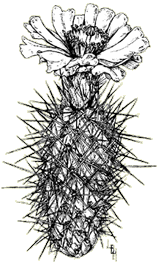 | 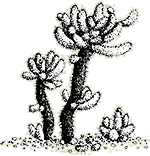 |
Description
This distinctive cholla has a vertical trunk 3 to 5 feet (1-1.5 m) tall with densely-packed horizontal side branches on the upper foot (30 cm) or so. Older, lower side branches die and fall off. The joints are very densely spined; very little of the living surface can be seen through its armor. The spines are especially sharp and strongly-barbed. Young spines are yellow and become black with age. Yellow-green flowers in spring are followed by spineless fruits that usually contain no fertile seeds.
Range
Teddy bear cholla is widespread and abundant in the warmest parts of the Mohave Desert and the hotter, drier parts of the mainland Sonoran Desert. A few widely-scattered populations occur in Baja California. South-facing rocky slopes are preferred.
Notes
The detached joints will readily generate new plants by rooting and branching. During the cooler months the terminal joints are detached by a slight touch by a passing animal, or even strong winds. The joints that attach to animals may be transported considerable distances before being dislodged. Since the fruits rarely contain viable seeds, this species reproduces almost entirely by this asexual process. Many plants have 3 sets of chromosomes instead of the ordinary 2; these are usually sterile. In some localities they form nearly impenetrable stands that occupy as much as 2 square miles of land almost to the exclusion of other plants. These giant, hillside-engulfing cholla forests may be a single (clonal) plant. See the next species for a remedy for close encounters with this plant.
Opuntia fulgida [Cylindropuntia fulgitda]
English names: jumping cholla, chain- fruit cholla
Spanish names: velas de coyote (coyote’s candle), cholla, brincadora (jumper)
Description
Another tree cholla that somewhat resembles the preceding species, Opuntia fulgida differs from O. bigelovii in being less spiny, larger, and often having several trunks. It averages about 8 feet (2.5 m) in height; in good soils it may exceed 12 feet (3.7 m). Small, about 1 inch (2.5 cm) pink flowers open in the afternoons during the summer. Flowers grow from previous years’ persistent fruits to form branching, pendant chains up to 2 feet (60 cm) long.
Range
Chain-fruit cholla is common in south-central Arizona and most of Sonora.
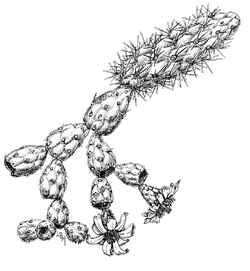 |
Notes
The ecology of jumping cholla is much the same as that of Opuntia bigelovii. One difference is that O. fulgida fruits often contain viable seeds, though they rarely sprout. More commonly whole fruits fall to the ground or are transported by animals that eat them and, like the joints, sprout new clonal plants from the fleshy rinds. (The fleshy part of cactus fruits is stem tissue; this tissue bears areoles with dormant buds that can sprout branches.) Because of the usually short dispersal distance of detached joints and fruits, jumping cholla tends to form dense clonal colonies. In contrast to teddy bear cholla’s preference for rocky habitat, jumping cholla grows better on the finer soils of lower bajadas and valleys. Extensive forests may consist of only a few clonal individuals.
Teddy bear and jumping chollas are surrounded by tall tales. One myth is that the joints are attracted to the moisture in animal flesh. Many people believe that they really do jump, and some even claim to have caught them in the act. The truth is that the very sharp spines are so well-barbed that even if one barely penetrates skin or clothing, its grip is stronger than the connection between joints. If you pass a jumping cholla and turn to look when you feel a tug on your clothing, you may see the joint detaching and flying through the air as the elastic recoil of the cloth snaps it into your flesh. The double surprise of seeing a plant moving faster than you and the sharp pain of impalement leaves a lasting impression.
The easiest way to remove a cholla joint is to place a comb between it and your (or your dog’s) skin and quickly jerk it away. Because of the barbs it will take considerable force (and teeth-gritting) to dislodge it, and the joint may fly several feet. Make sure a hapless companion is not in the line of fire!
Opuntia leptocaulis
English names: Christmas cholla, desert Christmas cactus
Spanish names: tasajillo, agujilla (little needle), tasajo
Description
This short, sparsely-branched shrub is composed of very thin, J inch (3 mm) stems to 2 feet (60 cm) tall, sometimes much larger when supported by other shrubs. There is one 2-inch (50 mm) spine per areole and many glochids. The ¼-inch (13 mm) flowers are typically pale yellow; they open in late afternoon in May and June and close at dark. Mature fruit is bright red and persists on the plant through the winter, hence the English names.
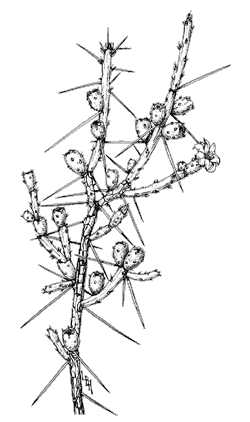 |
Range
This plant is widely distributed from Arizona to Oklahoma, Texas, and northern Mexico.
Notes
Christmas cholla often clambers among the branches of shrubs, so it tends to be inconspicuous except when it has ripe fruit. These cacti, growing within apparently harmless bursages and creosote bushes, have ambushed many hikers. This plant is rather unusual in having flowers that are open for only about 3 hours a day. One would expect that it has a specific relationship with a pollinator active in the late afternoon. But no special insects have been seen visiting it, just hummingbirds, honeybees, and one of the cactus bees. It does not seem to be attractive to moths despite its pale yellow color. Pencil cholla (O. arbuscula) looks similar, but is a larger plant with a distinct trunk and stems 1/4 inch in diameter.
Opuntia engelmannii [Opuntia phaeacantha discata]
English name: Engelmann prickly pear
Spanish names: nopal, abrojo (spiny plant), vela de coyote (coyote candle)
Opuntia phaeacantha var. major
English name: sprawling prickly pear
Spanish names: same as above
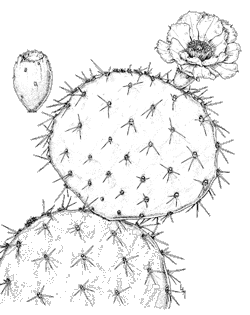 |
Engelmann prickly pear is a shrubby cactus forming hemispherical mounds up to 5 feet (1.5 m) high and 2 or 3 times as wide. Pad size varies with individual plants; the largest are over a foot (30 cm) long. (these giants may be hybrids with other species.) The spines are also variable. The O’odham recognize this variability in applying 4 or 5 names to different forms. The flowers are yellow, about 3 inches (8 cm) in diameter, and bloom in May near the end of the spring flowering season. They last a day each, and those of some plants age to orange by afternoon. The juicy fruit ripens to varying shades (from plant to plant) of rich purple to red. The specific status of this plant is still in dispute; it has been shuttled between Opuntia phaeacantha, O. discata, and O. engelmannii by different taxonomists during the past few decades.
Sprawling prickly pear in its pure form grows horizontally and is rarely over a foot (30 cm) high. Plants can grow to over 15 feet (4.5 m) across. The flowers and fruit are very similar to Engelmann prickly pear. These 2 plants hybridize freely with each other and sometimes with other species, so it is often difficult to identify a particular plant.
Range
These 2 species are the most common prickly pears over much of the arid Southwest from inland Southern California to central Texas and south into northern Baja California and central Sonora.
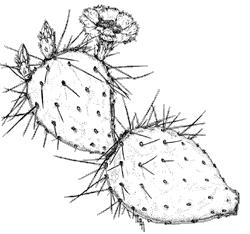 |
Description
Notes
Engelmann and several other species of common, large prickly pears present an ecological mystery. The juicy, palatable fruits ripen in tremendous numbers in July and August. Most saguaro fruits, produced in similar abundance earlier in the summer, are devoured the same day they ripen. But Engelmann prickly pear fruits persist for several months. Though they are eaten by a wide variety of animals including rabbits, packrats, javelina, deer, squirrels, numerous birds, desert tortoises, and cactus beetles, there are far too many fruits for them to consume. Moreover, the fruits in the centers of large plants are out of reach of several of the wildlife species that would eat them; many of these fruits are still present in November fermenting and shriveling. Why would a plant seemingly waste energy in such overproduction? Could there be a vacant niche, a missing seed-disperser? The large, very hard seeds offer another possible clue. It has been suggested that some prickly pears coevolved with the now-extinct giant mammals, such as mammoths and ground sloths. It’s an intriguing theory and, if proven true, further illustrates the already-established fact that natural systems are anything but static.











